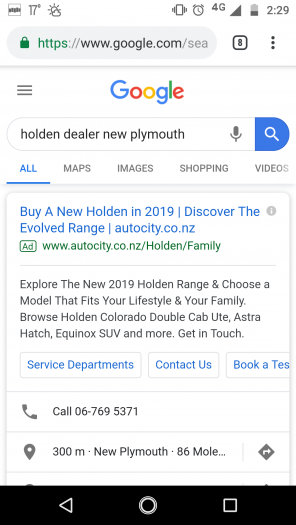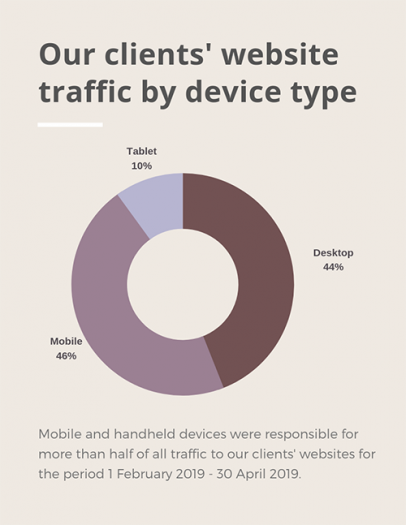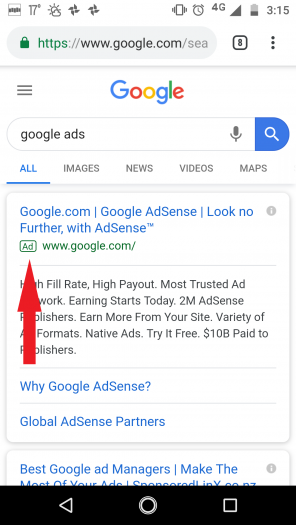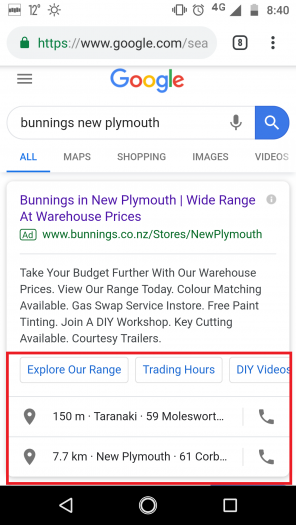We aim to respond to all messages within 1 business day. You'll be hearing from us soon!
In the meantime, perhaps you'd like to learn more...
Google Ads dominates mobile search results
Since their coming of age shortly after the millennium, smart phones have revolutionised the way we use the internet.
In 2000, Google helped businesses connect with online audiences with the launch of their Google Ads advertising platform (originally Google Adwords). Today, Google Ads listings dominate search engine results pages (SERPs) on mobile screens — screens which are now responsible for more than 50% of the world’s internet usage.
This month we look at the huge role Google Ads plays for companies looking to be seen online by mobile users, and how the reliable source of website traffic will only continue to grow.
Where do Google Ads appear on SERPs?
The short answer is… at the TOP. If a SERP was a pyramid, Google Ads would be the pointy bit at the top.
But let’s take a minute to explore the landscape of a Google SERP. What was once referred to as the ‘ten pack’ for its list of ten blue link results, is now a layered and rich wealth of personalised information and potential paths for the user to head down.
A Google SERP can now feature Special Content Result Blocks (SCRBs) like the local pack (a Google map highlighting three business listings in the user’s local area), featured snippets and Knowledge Panels; Google Ads ad listings (PPC advertising); and organic search results. Learn more about where your business could appear on Google SERPs over on our sister company’s blog.
SERPs are search-specific, but Google Ads are always atop
In an effort to serve each user a set of results most relevant to them, Google SERPs can be personalised based on the user’s previous search history, their location, their device and location settings and their behaviours on SERPs (i.e., which links they clicked and whether or not they found what they were looking for).
Regardless of any personalisation or which device the user is viewing the SERP on, Google Ads are always at the top of the page and the first thing the user sees. The size of Google Ads and the fact that there can be up to four of them at the top of a SERP means that mobile users will often have to scroll down several times before they reach the first organic search result.
Below is an example of a mobile SERP for a ‘holden dealer new plymouth’ seach query. Note that the first Google Ad result takes up the entire screen immediately visible ‘above the fold’ (without scrolling down).

How many customers are searching Google on mobile devices?
Top mobile phone companies like Apple and Samsung have poured so much technology into their products in recent years, we’re now walking around with miniature computers in our pockets. They are intuitive little machines that enhance the way we communicate, shape how we search for products and services, and affect how we live our lives in general.
These days if we need something for home, work or hobby our first port of call is to pick up our phone and perform a Google search to A) educate ourselves on the product or service, and then B) find the best deal.
Mobile usage by the numbers
With this behaviour in mind it’s no wonder that in 2018 more than 50% of all global web pages served were viewed on mobile devices.
For some perspective on how internet usage is impacting the world on an economic scale — the world wide web influenced retails sales worth $2.84 trillion in 2018 and that number is expected to rise to $3.54 trillion in 2019.
Google drives a huge amount of this with 3.5 billion Google searches being performed every day. And potentially the most important takeaway — more of these searches are performed on mobile devices than on computers.
When we look at the traffic visiting all our clients’ websites combined (across various industries), the proportion of users browsing on mobiles and tablets is greater than that of desktop or laptop.

Why do Google Ads receive such prominence on SERPs?
Google’s number one priority is to improve the user experience for individuals typing search queries into the Google search engine. Everything they do is geared towards serving the user with a set of results that match their search intent and provide them with answers relevant to the questions they are asking.
Because search queries (keywords) are the cogs that propel the Google Ads vehicle, it’s very easy for Google to serve users ads that closely match their search intent. As such, Google Ads is a highly targeted advertising platform and as such Google give their ads top billing on SERPs.
Google Ads are a cash cow for Google
The previous two paragraphs are the answers Google will be fastest to give us, but the almighty dollar is the more important motivator they aren’t so forthcoming about.
Search advertising (of which Google Ads is the cornerstone) is an absolute cash cow for Google. In 2018 Google’s advertising revenue was $116.3 billion USD. By putting Google Ads at the top of SERPs and making them (potentially) larger than organic results, Google are simply giving their biggest earner pride of place. In turn, they are encouraging more businesses to sign up for the service to make their brand more visible on SERPs.
Why do Google Ads work?
In the early days there was an ignorant stigma about Google Ads: where they would take you if you clicked on them; and in some sad cases, even who was getting charged for them.
Proof of the fact that any prejudice has diminished is the outright (and growing) success of Google Ads, which wouldn’t be happening if users weren’t clicking on Ads. Clicking on an Ad is often the easiest (and best due to keyword targeting) choice for mobile users, so the growth of Google Ads is undoubtedly following the upward curve of mobile internet usage.
Designed integration with organic results
Google have carefully designed their Ads to integrate seamlessly into SERPs, making them look almost identical in appearance to organic results — the only discerning feature being the small ‘Ad’ moniker highlighted below. This is cleverly designed to garner more clicks for Google Ads campaigns and generate more revenue for Google and their clients.

Google Ads are interactive for users
The next battle after establishing a company’s online visibility is encouraging user engagement. This means creating a user experience that wills the user to take the next step, make the next click, on the journey to converting their website visit into a business transaction.
Google Ads help engage users on the SERP (before they even get to the website) with Extensions which show clickable links that take the user to specific pages on your site, or click-to-call phone numbers that prompt their mobile phone’s dialler so they can phone you directly from the SERP. See the example below showing three Sitelink extensions and two Location and Click-to-Call extensions.

How to compete against your rivals if you don’t run Google Ads?
As the number of Google searches on mobile grows and the amount of internet traffic on mobile increases, Google will only continue to give Google Ads the prime mobile ‘screen estate’. It’s already hard to compete with businesses who are running a Google Ads campaign targeting the same audience as you, and it’s only going to become more difficult.
The best course of action if you forego PPC advertising is to ensure you are doing everything you can to boost your online visibility across Google’s other SERP features. Here are three ways you can put your best non-Google Ads foot forward:
1. Make your content KING.
Ensure your website is replete with high quality content that shows your company’s authority in your field and the worth you can offer the end user. Quality and relevance of content is one of the signals Google use to determine your SEO rank and resulting online visibility. Learn more about how to nail on-page SEO.
2. Use GMB to leverage your Local SEO.
A Google My Business listing is an excellent method of both providing potential customers with helpful information about your business and boosting your chances of making it into the Local Pack on Google SERPs. Read how to penetrate the Local Pack.
3. Ensure your technical SEO is tip-top.
To better your chances of appearing in the organic results (most often below Google Ads) on SERPs, we suggest a technical SEO audit to help ensure your website is sending all the right signals to Google.
What is the future for Google Ads?
Unfortunately for SMB owners, organic reach is becoming increasingly difficult to achieve across Google and Facebook. Google are favouring PPC (pay per click) and Facebook have changed tack and are favouring user-generated organic posts over those made by businesses — nudging businesses in the direction of paid Facebook advertising.
To keep pace with these changes smart business owners will weigh up the financial outlay involved with running a Google Ads or Facebook Ads campaign, and the potential impact the resulting traffic and conversions could have on their bottom line.
Choosing your journey to Google SERPs
We’ve laid out the methods of getting your business in front of mobile users by way of Google SERPs and we’ve talked about where on their mobile screens your listing may end up. Now it’s over you to decide which path you’d like to take and how visible you’d like your business to be to the ever-growing segment of mobile users.
Google Ads works on a PPC model up to a set daily click budget that can be as high or low as the account owner wants it to be. The effects of campaigns can be easily reported with great insight and the results are usually that of an excellent ROI. Drop us a line if you’d like to learn about the mechanics of Google Ads and how we can help you appear at the pointy bit of the Google SERP pyramid.
Related posts
AWESOME! LET'S GET STARTED
TELL US HOW WE CAN HELP
We aim to respond to all messages within 1 business day. You'll be hearing from us soon!
In the meantime, perhaps you'd like to learn more...





